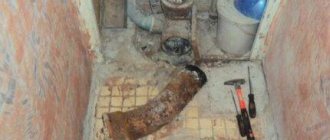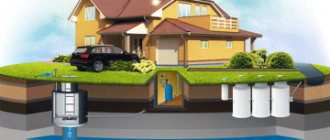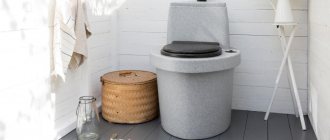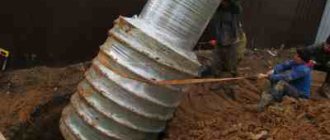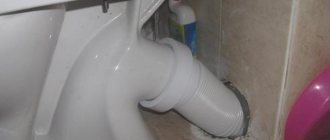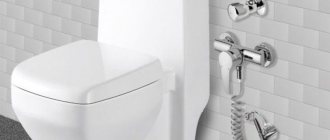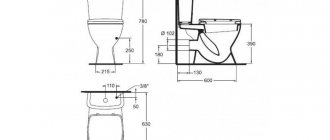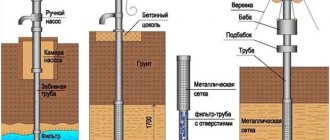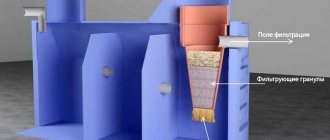- What is the difference between toilets with different types of flush?
- What specific parameters does a toilet with a vertical flush have?
- How to install a direct flush toilet?
- How to properly use a toilet equipped with a direct flush?
Every modern person takes the process of choosing various interior items and plumbing fixtures very carefully and seriously. The comfort of using a particular element, as well as its durability and reliability, depend on the right choice. This includes the toilet, which should be comfortable and of high quality, as well as quite attractive. Additionally, when choosing, it is important to focus on the installation nuances and features of this element. For example, often the only possible choice is a toilet with a bottom flush, which is installed in those houses or apartments where the main sewerage elements pass under the floor and not in the walls. In other cases, you will have to focus on purchasing other types of products.
Pros and cons of vertical release
To properly install any plumbing fixture, you need to understand its design features and operating principle. Models with vertical outlet include a siphon and a pipe. These are built-in elements; you do not have to purchase them before installing the device.
If toilets with a horizontal outlet have to be installed next to walls, then models with a vertical outlet can be installed anywhere. The main thing is that the sewerage layout allows this
Thanks to the complete set of the toilet, it can be installed anywhere in the bathroom. The devices do not take up extra space, so they can be successfully installed even in very small toilets of small apartments. It is only necessary that the sewer pipe be located in the floor slab.
A vertical outlet is convenient if the sewer pipe is flush with the floor. This is an excellent solution for private houses and Stalin-era high-rise buildings
Release to the floor has several advantages:
- Flush efficiency. Wastewater is easily drained into the sewer.
- Layout options. When designing the interior of a bathroom, be sure to take into account the specifics of the sewerage layout. Connecting a toilet with a vertical pipe expands design possibilities.
- Masking of communications. The sewer pipe is located directly under the plumbing fixture. There is no need to look for ways to hide or decorate it.
- Hygiene. Models with vertical flush always have more water than devices with other types of outlet. Thanks to the siphon, waste flows into the pipe faster and better, so the bowl is better cleaned.
- No splashing. Fewer splashes mean you have to clean the toilet less often.
- Reliable tank. Typically, models are equipped with good quality drain tanks.
The drain runs under the floor. If the system is being installed from scratch, this can be difficult because you have to cut a separate hole in a solid concrete slab. If the pipes are already laid, there should be no problems.
In private houses, sewerage often runs under the floor, and access to the elements of the system can be obtained from the basement. This is very convenient in case of repairs
In some houses it is impossible to install appliances with a drain type other than vertical. First of all, this applies to buildings of old construction, for example, Stalinist ones.
An alternative is the release of vario, but with it there are serious installation difficulties. In houses built in recent decades, pipes are laid above floor level. You can install devices with any outlet.
Drain system
The toilet tank is probably the main structure. The functioning of the unit depends on its operation. Without a cistern, a toilet is nothing special. There are many types of tanks, and you need to be able to make your choice correctly.
Toilet flush tank
There are two types of flushing mechanism in tanks:
- Single-mode.
- Double drain.
In the first option, we press a button or pull a string, and all the water rushes into the toilet. If you want to save water, which is especially important if you have a water meter, then it is advisable to install a double flush mechanism. This model usually has a double button. If you press one, all the water pours out of the tank; when you press the second, only half of the tank is emptied.
Tanks with another “stop mode” have appeared on sale. In this case, there is only one button, the first time you press it, the flush starts, and if you press the button again, it stops.
The buttons can also be located in different ways: on the tank lid, on the side wall or on the front panel.
Depending on how the water is distributed, the drainage can be:
- Straight;
- Back.
We see the direct option in our apartments most often, because it is practiced in domestic toilets. After pressing the button, water is directed into the toilet bowl in a large flow. In this case, a lot of noise is heard and a large amount of splashes is generated.
Using the toilet
Foreign plumbing has a reverse drain. In this case, the water is supplied in an arc, and its flow evenly washes the entire bowl, while all this happens almost silently. Not only the absence of noise distinguishes such a system, but also the economical use of water.
Toilet bowls may also differ in the type of flush. It is very important for us that everything that ends up in the toilet is removed from there without leaving a trace. This directly depends on the direction of the water jet. It can come out in different ways:
- Cascade drain;
- Shower.
In the first option, water will wash the entire bowl along the inner walls. During the shower, it rushes along the perimeter of the bowl and forms a funnel into which the entire contents of the bowl are drawn.
You can find another system in which water first fills the toilet almost completely, and then it all suddenly rushes into the sewer. Of course, this option is not very economical, although there are models with an economical mode.
Step-by-step installation instructions
The advantages of models with vertical flush include ease of installation. Even a non-specialist can handle the installation.
It is important to adhere to the established work order and perform all operations as carefully as possible. Negligence is unacceptable, because later, leaks and an unpleasant smell in the bathroom may appear.
Stage 1: dismantling the old structure
First, turn off the water supply, after which the remaining liquid is drained from the tank and the supply hose is disconnected. Now you can dismantle the old toilet.
If it is fixed to cement mortar, it is unlikely to be removed without damage. However, it is important to maintain the integrity of the pipe, so the solution is knocked down carefully, without touching the elements of the sewer system.
It's a dirty job. It is best to perform it with gloves and overalls. During the dismantling process, it is important to promptly remove water and clean off contaminants, so that later it will be easier to prepare surfaces for installing a new structure
You need to remove water from the bowl. To do this, the toilet is tilted slightly, then loosened and raised. Sometimes you can’t get by with a little bloodshed. Then, in order to quickly separate the product from the sewer pipe, you need to hit the drain neck with force. It will crack, and the remaining parts of the structure will become loose from vibration. They will be easier to remove.
The following article will introduce you to the details of dismantling old plumbing, which we highly recommend reading.
Stage 2: marking and preparation
It is better to install a new toilet in place of the old one, because... moving communications and replacing pipes in a toilet is not an easy and time-consuming job. To complete it, you need skills and experience. Before installing the product, the surfaces should be thoroughly cleaned and leveled.
The installation site is measured and the location of the plumbing and sewer pipes is outlined. According to the finished marking, a screw flange with a lock is inserted.
Installation of models with vertical flush is considered the easiest due to the presence of a screw flange with a lock. Its counterpart is located at the bottom of the toilet. Simply connect the elements
A standard screw flange has a round hole into which the end of the sewer pipe is secured. After fixing it, all that remains is to make sure that everything is done correctly and that the surfaces are clean and prepared for installation of the plumbing fixture.
Stage 3: toilet installation
If everything is perfectly prepared, the vertical flush device is installed with a “light movement of the hand.” The product is simply placed on the flange so that the mating part is located strictly above the opening of the sewer pipe. Then the toilet is turned slightly so that the latch works.
This is a simple operation that does not require any special effort. Once the flange automatically attaches the toilet to the pipe, the installation can be considered complete
At the moment of rotation, the flange presses the outlet pipe of the device against the sealing ring. The connection is completely sealed. If everything is done carefully, leaks are excluded, because The seal reliably compresses the toilet outlet, eliminating possible gaps.
Stage 4: connecting to the water supply
All that remains is to assemble the tank, install the drainage fittings into it and finish connecting it. This is done using the so-called. water outlets, which are provided in all bathrooms. Taps are put on them and sealed with fum tape.
Elements designed to collect water and drain it from the tank are called fittings. Sometimes when installing a toilet, it has to be adjusted so that water is normally drawn into the container and does not drain into the bowl spontaneously
One end of the supply hose is connected to the outlet of the faucet, and the other to the outlet of the drain tank. All joints are carefully sealed. When the work is finished, all that remains is to check the functionality of the toilet.
The easiest way to install a compact toilet cistern. The elements are initially designed to be installed together, so there is no need to look for separate parts. The kit also includes a seal, fasteners
Open the water supply tap, wait until the tank is full, and then press the drain button. At this time, feel the joints and rub them with a dry white cloth. If there are no traces of moisture, everything is in order: the toilet is completely ready for its intended use.
Classification of toilets
We have already found out that toilets differ from each other in many ways. It turns out that the bowl itself can influence the efficiency of work. We have already looked at bowls with a shelf and a vertical drain. In Russian toilets, the neck is most often located closer to the front edge of the toilet, although there are models with a different location.
This is provided in any case, because the neck cannot go directly into the drain, otherwise all gases from the sewer will in this case pass into the room. To prevent this, every toilet has a siphon, or otherwise called a water lock. It looks like a curved tube, it definitely contains water.
Some people are mistaken in believing that the more vertical the drain is, the closer to the wall the device should be placed. But this cannot always be done, because toilets are divided into:
- Direct toilet flush;
- Oblique;
- Vertical.
You don't have to choose a drain, because you need to buy a toilet with an outlet that fits your sewer system. If you are building a house with your own hands, you can first decide on the choice of toilet, and then install a sewer system for it.
The most versatile is the oblique projection; if desired, it can be connected to any outlet of the sewer pipe. Direct drainage is suitable for you if the pipe neck is located at a certain height from the floor. A location below the floor may be suitable for a vertical drain.
Replacement with a model with a different drain
Is it possible to replace a device with a vertical outlet with a model with a different type of drain? Yes, if the area and location of the plumbing allows you to move the toilet by at least 15-20 cm. To connect to the sewer, you will need a plumbing corrugation.
Work order:
- The old toilet is being dismantled. A new one is placed in its place so that it is as close as possible to the sewer pipe.
- The pipe of the device is coated with silicone sealant, and a corrugation is put on it.
- The second end of the corrugation is inserted into the sewer pipe and fixed.
The folds of the corrugation should straighten without dents. It is necessary to ensure that its slope is directed towards the sewer pipe.
How to properly use a toilet equipped with a direct flush?
The care, maintenance and repair of this product are considered simple, but it is important to know how to use such a toilet correctly so that it lasts for a long time, and at the same time always retains its functions and parameters. It is important to constantly provide it with proper care, which consists of using a drain after each use of the element, and if dirt forms on its walls, they must be removed using suitable tools and cleaning products.
It is also important to periodically check the integrity of all elements of this plumbing fixture, and if any problems or leaks are detected, it is necessary to carry out repairs correctly, which will ensure their prompt elimination.
Thus, toilets that have a direct flush are becoming increasingly in demand among developers and private owners who are building their own private homes. This is due to the high parameters of these products, as well as the fact that they are very convenient and pleasant to use. At the same time, you can even increase the efficiency of the sewer system due to more efficient drainage.
How to properly care for a new device?
Plumbers recommend installing coarse filters along with the new toilet. Tap water contains solid particles and pieces of scale from metal pipes. Getting into the tank along with debris, it provokes abrasion and premature wear of parts.
If the filter is not installed, you should take care to timely clean the drain tank so that you do not have to repair or replace damaged elements ahead of time. The structure is disassembled, limescale is removed, and the parts are washed with clean water.
You can remove limescale deposits by throwing a special tablet into the storage container. It will dissolve water stone, clean and disinfect the tank, and flavor the water. Citric acid is suitable as a folk remedy.
To avoid leaks at the junction with the sewer, preventive maintenance must be carried out. A pipe cleaning chemical (“Mr. Muscle”, Tiret, “Chister” or any other) is poured into the toilet and left for the time indicated on the package. Aggressive substances corrode plaque on the walls, which prevents blockages.
It is not necessary to spend large sums on store-bought household chemicals. Baking soda and vinegar can give the same result: flush pipes, disinfect, eliminate odors
You need to clean the toilet at least a couple of times a year. It is important to choose the right cleaning products, taking into account the characteristics of the materials from which the pipes and the device itself are made.
Choosing a toilet
When going to a plumbing store to purchase important equipment for a sanitary room, there are a few things to consider that you need to pay special attention to.
- Dimensions of your toilet.
- The material from which the toilet is made.
- Type of bowl.
- Flush design.
- Flush tank.
If your room is very small, then it is better to choose a hanging model; you will be able to save at least a little space. More recently, toilets without tanks have begun to appear on the market. The flushing device is installed directly into the water supply system.
Toilet design with dimensions
The material is also important. It will determine how often you will have to clean this equipment. Toilets are usually made of earthenware or porcelain. Porcelain is considered more durable, but this quality should not be the main thing when choosing. These two materials differ in structure. For this quality, porcelain is preferable to choose, because it is very easy to clean and does not get dirty so quickly.
Earthenware has more pores, so dirt is attracted to it more strongly, and it quickly loses its attractiveness. Although, some manufacturers are not asleep and are looking for a way out of this situation. Many people succeed in making faience less porous during the production process, and then its service life can increase, and dirt will be much easier to remove.
The toilet bowl also comes in different shapes:
- With a shelf located horizontally;
- Vertical flush.
The first type occurs mainly in old-style equipment. The shelf is provided to absorb the splash of water when flushing. The toilet remains dry for a long time. This is important, because with the constant presence of liquid, the bowl quickly loses its whiteness. Nowadays, bowls with vertical drainage are in demand; they are similar to funnels, only there are options with and without offset. The offset funnel keeps splashes out, but with a bowl like this you will need to clean it frequently.
Toilet bowl
If you decide to purchase a bowl with a vertical drain with an offset, then you must check the flushing mechanism so that it washes the bowl as best as possible. The flush design can be of three types, depending on the sewerage system in your home. Currently, toilets are produced in three editions:
- Vertical.
- Horizontal.
- Oblique.
The oblique release is the most common, as it is more versatile and convenient for making the connection yourself. On the one hand, the vertical one is good, it is often used in the private sector, but it has one drawback: it cannot be remade.
In new houses that have been built recently, horizontal exhaust is usually used. The drain column usually comes complete with the toilet and there are a huge number of their varieties. When choosing a cistern, you need to pay attention to efficiency and quiet operation.
